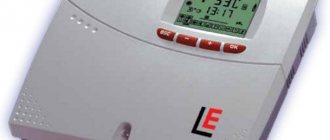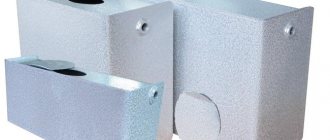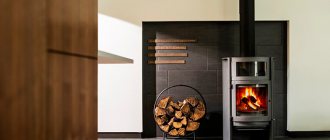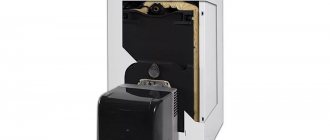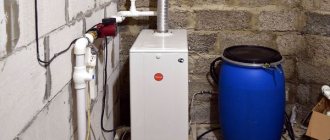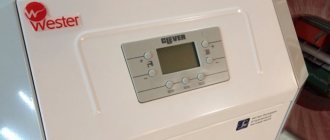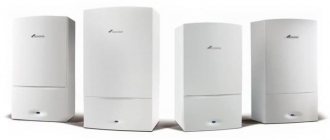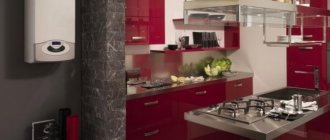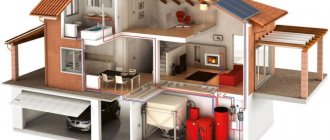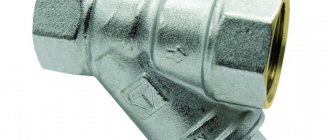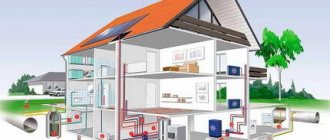A GSM controller is an electronic device designed for automatic and remote monitoring and control of any electrical equipment. The range of applications of the GSM controller is wide. This can be performing the functions of a simple GSM switch or GSM relay, controlling a barrier and gate, lighting, performing security functions, measuring the temperature of the environment. Separately, it is worth noting the possibility of advanced control of heating boilers. It is possible to control devices that have an input for connecting external (room) thermostats. The GSM controller is connected to the corresponding boiler input, and the temperature sensor is installed in a convenient place in the room. When the indicators change, the controller program reacts to this by changing the heating mode. The user can also receive notifications about changes in temperature and power parameters. You can start and stop the operation of connected equipment from a distance, and the GSM thermostat independently regulates the temperature mode.
Expert advice: how to protect yourself from controller breakdowns
Repair of control units for gas boilers is not a common occurrence.
However, before purchasing equipment from a certain manufacturer, ask if there are service centers in your region. To protect yourself from troubles at the wrong time, you should, with the help of specialists, inspect the boiler before and after the heating season. A network voltage stabilizer will help protect the electrical controller from pressure surges, thereby protecting the device from damage.
You can prevent possible damage to the control unit the first time it is put into operation. The unit system is complex and fragile in its own way; settings may be lost during transportation or assembly of the equipment. Therefore, during installation, they first carefully check all the subtleties associated with the wiring, water and gas supply, and then check the operation of the CU sensors.
The latest models of controllers have been brought to almost complete independence. The gas boiler control unit reports faults using indicators, as can be seen in the diagram below.
If you notice any failure, even a minor one, it is better to immediately call a boiler service specialist, this will prevent a serious breakdown and save yourself from more serious problems.
Disadvantages of weather-sensitive automation
Here, oddly enough, there are much more significant positions
- Price if we are talking about a floor-standing boiler.
- The main disadvantage of external weather-compensating automation that is not built into the boiler is the difficulty of maintenance. Often, people call repairmen without even knowing the model of their controller. There are a lot of controllers, so they don’t carry them with them, except in cases where they know exactly for what purpose and model of boiler they are going. The controller cannot be repaired on site. You have to pull out the wires that are connected to the controller and connect them directly. This is the worst case scenario. At best, they take the controller away, check it, and buy a new one. The result is unnecessary spending and worry. In contrast to the lack of weather-compensated automation. As a rule, nothing breaks there due to regular maintenance.
- With automation, which is connected to a large number of electronic devices, there are problems and it is impossible to eliminate them, you just need to change them.
Operating principle of the control unit (controller) for boilers
Controllers are electronic devices that are designed to optimize the control of a gas heating device under changing environmental conditions. The capabilities and functions of different devices differ, but they are united by the presence of pressure and temperature sensors.
The electronic gas boiler control unit (ECU) is responsible for the operation of the gas burner, heating of the coolant and the safety of the system as a whole. Its operating principle is based on the use of an electromagnetic valve.
The controllers of the latest heating devices are equipped with an automatic mode function, which allows you to regulate the operation of the device during the week without human intervention.
Connecting the computer to external temperature sensors and boiler control terminals allows you to configure independent changes in the operation of the burner.
What does a controller provide for temperature control in heating systems?
The introduction of automated control tools using a heating system controller opens up a number of possibilities for the owner. First of all, heating control from a special heating boiler control panel becomes available. The thermostat is located in any place convenient for the user. Thanks to this, there is no need to go to the equipment located in the boiler room in order to change settings, turn it on or off. Heating automation also offers the following advantages:
- Automatic maintenance of user-specified temperature. Automation maintains the required indicator regardless of external conditions. These include heating of the building by the sun's rays, the presence of a large number of people on the site, and a decrease in outside temperature due to bad weather.
- Achieving significant savings in energy resources and fuel. Automation uses resources to maintain a given temperature more efficiently than a person. As a result, the boiler operates for less time, heating is more efficient, wear of parts is slowed down - the service life is extended.
- The ability to remotely control the operation of heating equipment, for example, using a gsm heating controller. Properly configured automation allows the user to turn on, turn off and configure the boiler while being at a great distance from it. It also opens up the opportunity to quickly respond to emergency situations.
Automated heating can be interfaced with the Smart Home home automation system. In this case, the possibilities for adjusting the microclimate in the building become as wide and flexible as possible. This is achieved through the use of multiple temperature and humidity sensors located in all rooms of the house. Installation of actuators is also available to improve system security.
Due to the large number of advantages of automated control of a country house or cottage, the question does not arise about whether it is worth buying a heating boiler control panel or, for remote control, a gsm heating controller. This step is costly, but will ultimately lead to savings in money and time during the operation of heating equipment. It will also bring you many conveniences.
WHAT'S COOL?
The main thing is that Klimatic is the most inexpensive of the cool ones.
Or the coolest inexpensive one - whatever you like. It is easy to set up - large screen and clear menu.
It can work with wireless temperature sensors (radio communication). Moreover, one outdoor air temperature sensor can be used by several Climatics. This is in case you have several heating circuits.
It has 9 "factory" time programs such as "morning, evening and weekend". This saves a lot of time when setting up.
You can manually switch the Climate control to comfortable or economical mode at any time. And return it back to automatic.
The heating schedule can be adjusted (this is more for specialists).
The climate control system intelligently controls the pump and drive: if heat is not needed, the pump will turn off and the drive will close.
The climate control is always on guard! In any mode, frost protection is provided (if the coolant temperature drops below 10 degrees, the controller will turn on the pump and maintain 10 degrees).
Controls any three-position drives
Tips for organizing remote heating control
Connection diagram of modules to the heating control unit
In most cases, you can make a cottage heating control system yourself. This is only possible with the correct selection of system components. Those. First you need to analyze the condition and capabilities of the already installed equipment.
The classic heating system control unit diagram has one control unit, which is connected to all heat supply elements. The programmer must meet the following requirements:
- The number of connected terminals and their configuration must coincide with similar communication nodes of the boiler and thermostats. Otherwise, heat supply control via SMS will be impossible. If necessary, adapters are purchased;
- Maximum distance of the user from the control unit. If this distance does not exceed 300 m, you can purchase models with mine control. To increase the communication area, it is recommended to use heating control via a mobile phone or the Internet;
- The ability to independently (or with the help of specialists) set additional operating parameters. This is done with a controller based on heating control boards;
- Connecting an autonomous power supply unit. To do this, you need a sufficiently large heating control box. This parameter is taken into account when choosing the installation location of the control unit in the house.
Don't forget about the ability to control heating radiators. This can be done using local devices - mechanical thermostats. They are low cost, but cannot be connected to a common electronic control system.
Programmers and thermostats are the main heating control elements
Heating programmer
To organize autonomous heat supply, you will need electronic devices. They may have a heating boiler control panel and the ability to simultaneously change steam meters in several connected components.
These devices are called programmers or electronic thermostats. Like other similar devices, they can have heating control via SMS or the Internet. But these are just additional functions. To select the optimal model, you need to know the basic functional qualities of the programmer:
- Number of connected circuits . Can vary from 1 to 12. An additional module is installed to increase the number of connectors;
- System operating modes . Depending on the settings, you can set the control of heating radiators in economy, normal and comfortable modes;
- Plug-in module - heating control by phone . The GSM station transmits the required information via SMS - coolant temperature, emergency notification, etc.;
- The presence of radio transmitters to create wireless communication channels between connected heating components.
Collectively, the installed equipment is called the heating control frame. It may consist of components with different functionality. The purpose remains the same - the ability to automatically or semi-automatically change heat supply parameters.
Connecting the programmer to the boiler
But in addition to local devices, there are also zonal devices installed on specific components - boilers, radiators. By controlling heating via the Internet using these devices, you can regulate the degree of water heating in the system and the temperature regime in a specific battery. Often such devices are called not programmers, but electronic thermostats.
They are more affordable and easy to install. Thermostats do not require a heating control cabinet, which reduces the complexity of installation. In some cases, it is possible to connect several thermostats to a single control unit.
What should you consider when creating a smart heating budget? In addition to the cost of the control element, you need to know the approximate price of consumables - communication wires, heating control panel. The latter is necessary when installing a system consisting of several blocks - a programmer, a GSM module, expansion strips for additional contactors.
| Model | Purpose | Cost, rub. |
| Computherm Q3 | Wired thermostat | 1625 |
| Computherm Q3 RF | Wireless thermostat | 3367 |
| PROTHERM Kromschroder E8.4401 | Programmer. Control of 4 boilers, DHW, 15 heating circuits | 34533 |
| Heating control panel | RCD, boiler control units, connection to temperature sensors | From 7000 |
It is also important to consider the location - the heating control box should be installed in an accessible place. Its installation in a boiler room is not recommended, although this is the simplest option in terms of labor intensity. It is best to install it in a living room. Then it will be possible to monitor and change system parameters much more often.
Programmer models differ in the number of connected system components. They are called control circuits.
How does a controller work to control a heating boiler?
The boiler controller is the central node in the entire system. It sends signals to each of the elements and mechanisms, as a result of which the cyclic operation of the system is determined, and the parameters of all devices connected to it are changed and adjusted. In addition, it has a function for connecting to GSM-Monitor, which allows monitoring and regulation remotely and via the Internet. In case of failures or malfunctions, the boiler control controller will instantly turn off all components, and send a notification to the owner of the house on his mobile phone.
Any boiler control controller is a small electronic panel with which parameters are set and some functions are programmed depending on the data that comes from pressure or air temperature sensors.
The burner control controller regulates its operating mode and automatically records statistical data, which can be stored in the memory of the built-in computer for up to 20 years (depending on the controller model). The warning system is activated by an audible signal, indicating a problem or dangerous situation. The heating boiler will be turned off to avoid an accident. The controllers have a function to return to factory settings. As a rule, they involve automatically adjusting the fuel supply, maintaining a comfortable room temperature, and igniting the boiler. Automatic parameters are set based on the average air temperature and humidity in a particular region, which allows the user to ensure a comfortable microclimate in the room without unnecessary knowledge.
Purpose of heating controllers
The main purpose of this electronic device is to change the parameters of control devices connected to it to correct their operation. The simplest example of an elementary control element of this kind can be considered an automatic control protection system in gas boilers. But controllers for heating and hot water supply have wide functionality.
They are an electronic unit with the ability to control the main elements of the heating system. To do this, it provides the ability to program parameters depending on the data received, from external temperature and pressure sensors. Thus, a controller for a heating boiler can regulate the operation of a heated floor collector or individual thermostats on radiators.
The general characteristics of electronic control units include the following:
- System flexibility. To connect to heating components, you do not need to reprogram the device. In most cases, manufacturers provide several operating modes for one connection terminal;
- Possibility to choose a convenient location for installing the control panel. The Honeywell heating controller can be mounted at a distance of up to 100 m from the control element;
- Monitoring the functioning of not only heating systems, but also hot water supply;
- If you have a GPS unit, you can receive data online about the state of the heating and send commands to change its parameters.
The function of connecting the device to a computer is also important. A similar additional module is installed on the Aries heating controller. It is noteworthy that it is not included in the required package.
Review of popular controller models
Having decided on the required parameters of controllers for heating and hot water supply, you can begin to analyze the products offered. Despite the large assortment, the market is oversaturated with low-quality models. Their actual parameters do not correspond to the declared ones, which subsequently leads to incorrect operation of the heating. Let's look at truly popular and reliable examples of heating control controllers.
Honeywell
Honeywell controller
Among the entire product range of the company, the Smile SDC7-21N model occupies a special place. In addition to an affordable price, it is characterized by optimal functionality, which is important for heating system controllers.
It is important for the consumer to know the characteristics of an electronic device. It should be immediately noted that for optimal operation of the Honeywell controller in the heating system, you will need to purchase additional modules - terminal blocks for connecting system components, a set of temperature sensors, a 3-way mixing valve and actuators. After assembling the controller, it will be possible to control heating and hot water according to the following parameters:
- The ability to regulate the operation of the boiler burner with two-stage control;
- Simultaneous control of 2 cascade type boilers. But for this you will need to install an additional temperature sensor at the output of the second one;
- The controller for the heating system can regulate the direct and mixing circuit depending on the street and room temperature;
- DHW pump control;
- Possibility of setting a 7-day heating control program.
In its minimum configuration it will only work as a controller for a heating boiler. But this will not prevent you from purchasing additional modules and upgrading the system over time. The cost of a complete set is about 45 thousand rubles.
It is best to purchase a complete set of equipment, since all its components are guaranteed to work normally when connected to each other.
Automation design
All internal equipment of automation for gas boilers, which is used when installing a heating system, can be divided into categories, there are only two of them:
- the first category is those devices that ensure the safe and proper operation of all boiler equipment;
- the second category is those devices that can significantly increase the comfort when using the boiler.
Safety automation for gas boilers consists of the following elements:
- the module that provides flame control. It consists of a thermocouple and a gas valve that works like an electromagnetic valve and shuts off the fuel supply;
- there is also a device that protects the system from overheating and maintains the required temperature; this task is performed by the thermostat. It independently, if necessary, turns on or off the boiler at those moments when the temperature approaches the specified peak levels;
- the sensor that controls traction. This device works based on vibrations depending on how the position of the bimetallic plate changes. It, in turn, is connected to a gas valve, which stops the gas supply to the burner;
- there is also a safety valve, which can be responsible for discharging excess coolant (for example, air or water) in the circuit. Some manufacturers immediately provide an element that helps dump excess.
The devices included in the security system are divided into the following types:
- mechanical;
- and operating from a power source.
Automation provides the user with more comfortable functionality, which is additional:
- automatic ignition of the burner;
- flame intensity modulation;
- self-diagnostic functions.
But such functionality is not limited to the internal design of the models.
Some design features of the models include additions such as sending data and processing it by an electronic system on equipment equipped with controllers and microprocessors. Then the following situation occurs: based on the received data, the controller itself begins to adjust the commands that activate the machine’s system drives.
Mechanical automation of a gas boiler also requires detailed consideration.
- The gas valve is completely closed and the heating installation is inoperative.
- In order to start a mechanical gas boiler, the washer is squeezed out, allowing the fuel to start and opening the valve.
- The valve opened under the influence of the washer and gas flowed to the igniter.
- Ignition is in progress.
- After this, gradual heating of the thermocouple begins.
- The electric shut-off magnet is supplied with a voltage that ensures its open position so that fuel access is not blocked.
- Mechanical rotation of the washer regulates the required power of the gas heating device, and the fuel in the required volume and with the required pressure is supplied to the burner itself. The fuel ignites and the boiler unit begins to operate.
- And after that, this process is controlled by a thermostat.
Autonomous heating boilers - non-volatile automation.
Boilers equipped with non-volatile automation are protected from sudden power outages. As a rule, they operate without the use of forced coolant circulation, which means they can work autonomously. Such a heating device is controlled by boiler automation, the operation of which is based on the use of gases that can expand significantly under the influence of temperature.
A special sensor with such gas is installed at the top of the heat exchanger, where the temperature is highest. As the temperature of the coolant increases, it increases in volume and its pressure increases. The sensor, using a copper tube, communicates with the membrane, which, in turn, is mechanically connected to the valve that controls the fuel supply to the burners. With approximately the same type of action, a sensor is installed on Galan electrode boilers.
Using the controls, you can adjust the valve cut-off threshold, and thus control the water temperature in the heating circuit.
Non-volatile automation for boilers is installed, as a rule, in domestically produced parapet heating installations.
Modern control devices are electronic automation systems.
Modern automation devices for wall-mounted boilers operate on a different principle. They use a solenoid valve that is controlled by a microprocessor unit. This is explained by the fact that this control method makes it possible to more accurately regulate the operating mode and is more convenient for the consumer. The boiler is usually equipped with a display and buttons for controlling operating modes. Just a few clicks are enough to set the required mode, and then the smart electronic system itself will maintain optimal operating parameters.
Technically, the electronics in such boilers control a three-way valve and a circulation pump. A three-way valve with an electric drive allows you to switch the flow of coolant to provide hot heating of DHW water or to completely turn off the heating circuit. This is necessary, for example, in the summer when there is no need for heating. If the boiler operates only in the DHW supply mode, and there is no water flow, then the automation stops the circulation pump and turns off the burner.
Selecting a heating controller
In what cases is it necessary to install a heating control controller? First of all, this device is necessary when residents are often absent from the house or apartment. By connecting the electronic unit to external temperature sensors (outside and indoors) and the boiler control terminals, you can use the built-in software to set up an automatic change in the intensity of the burner operation.
How to choose the optimal controllers for heating systems? The easiest option is to consult with specialists. But nowadays it is difficult to find one, since this product is relatively new. Therefore, it is recommended that you first study the basic selection parameters yourself:
- When comparing a controller for a heating boiler, you should make sure that the installed equipment has the ability to connect to the control unit. Most often, the boiler is characterized by one-stage or two-stage external control. This applies only to gas models - coordination with solid fuel models is impossible;
- Number of managed components. For a Honeywell heating controller, this value can reach 15 depending on the specific model;
- Availability of GPS unit. As mentioned above, this function makes it possible to remotely control the heating;
- Software update frequency. The modern controller of heating and hot water systems TRM 32 can be connected directly to a computer. You can always find the latest software version on the manufacturer's website.
An additional function is to adjust the operation of the components according to the configured heating schedule. This feature is provided in the Aries heating controller
You should also pay attention to the accuracy of measurements. In professional models, this indicator should not exceed ±0.01 scale
Wired switching center Salus KL06.
Costs 4281r.
The KL06 controller is designed to connect thermostats and actuators into a single switching unit. There is an indication of the state of the servos.
Control of the pump and boiler is possible only after connecting additional modules Salus PL06 or PL07 (1700r and 2800r).
If you carefully read the Salus KL06 instructions, you will find out that this is a more cunning device than it might seem.
Fully functional with Salus thermostats.
PWM, VP, NSB SYSTEMS
The systems used in Salus ERT series thermostats provide more efficient control of floor heating.
PWM
Due to the high inertia of floor heating, the use of the PWM system in ERT series controllers guarantees us precise maintenance of a constant temperature in the rooms. The PWM system controls the operating time and the opening and closing frequency of the used servomotors in relation to the rise in room temperature. The result is additional savings, comfort, and no overheating of the room.
V.P.
This is a system that protects and extends the life of servomotors. Opens and closes the servomotor once a week, even if the system is not currently operating (outside the heating season).
NSB.
Temperature reduction function - NSB (Night Set Back). The system provides the ability to influence the temperature depending on the time of day, which guarantees efficient control of the heating system. The temperature reduction function allows you to reduce the temperature by 4°C, without adjusting the thermostat, even with non-programmable controls in most zones.
The NSB function in the regulators is activated by an external signal transmitted to the Salus KL06 bar using the Salus ERT50 weekly thermostat. This regulator must be connected to the field marked number 1.
All regulators must be connected using a 4-wire wire, according to diagram number 1.
If you do not enable the clock field, the MSB function will not be active, but the other controller functions (PWM and VP) will work.
Here are the connection diagrams for thermostats.
The connection diagram for the ST320 thermostat is unusual - let's see what's in the datasheet of this thermostat.
It seems that the thermostat controls exactly 220V, passing or not passing through itself. If so, then the Salus KL06 controller may be suitable for working with thermostats that provide 220V for load control.
I don’t like it visually, and with a pump and boiler connection module it costs more than 6000 rubles and has open terminals. I will not have Salus thermostats, so the “smart” functions are not available.
Device Description
The described device has a number of other capabilities:
- The module informs the owner of the house about the interruption of gas or electricity supply.
- If an error occurs in the operation of the heating boiler, the owner receives a message.
- The control unit also signals the owner about a gas or coolant leak from the system.
- In the absence of family members in the house, the heating system can be programmed to use energy economically. To do this, a command is given to the control module using a message or call.
- The owner of the house, with the help of a call or message, has the opportunity to receive up-to-date information about the condition of the boiler and other system parameters, as well as clarify the temperature of the coolant and air in the house.
Let us consider in more detail the operating principle of GSM heating control using the example of the domestic complex “XITAL GSM-4T”.
Primary sensors
Their task is to signal the operating parameters of the boiler.
In other words, the sensors transmit indicators to the control unit, which makes a decision about the need for one or another action. Let us immediately clarify that not every gas heating boiler has all of the sensors listed below as standard. Their availability depends on the model.
Coolant temperature sensor. Helps the controller regulate the burner flame. As a rule, a gas heating boiler has two such sensors: one monitors the temperature of the liquid at the outlet of the heat exchanger, the other signals how much the coolant has cooled in the return pipe (“return”) after passing through all the heating devices in the house. The resulting temperature difference (ΔT) allows the controller to issue a command to increase or decrease the intensity of the gas burner, up to turning off the boiler.
Flame sensor. The full name of this device - “flame sensor on the burner” clearly explains its purpose. If the torch goes out, the sensor will give a signal and the controller will take action to re-ignite or, in the event of a malfunction, completely turn off the boiler.
How does the flame sensor work in advanced models?
If the gas heating boiler has a more complex controller, then the flame sensor helps to combat such violations as “separation” and “breakthrough” of the flame. In both cases, the torch is in the wrong position, this leads to uneven heating, which causes the heat exchanger to fail. Flame separation is a phenomenon in which fuel combustion occurs not at the burner, but at some distance from it; This is due to excess gas pressure. Insufficient pressure leads to a breakthrough: the torch “goes” into the pipe, and the fuel burns even before the burner, which can damage the gas pipeline.
Exhaust gas analyzer. It controls the composition of the atmosphere in the chimney: deviation of the mixture of gas and air from the norm leads to the formation of free carbon (soot) and hydrogen, the presence of which is recorded by the analyzer. Based on its readings, the controller changes the parameters for preparing the mixture, usually by increasing or decreasing the gas supply. This sensor is usually found in advanced gas heating boilers.
WEATHER DEPENDENT - HOW IS IT?
Heating system designers design systems for the coldest days of the year (the coldest five-day period). And it is on these days that the boiler must produce the calculated coolant temperature - as a rule, the maximum it is capable of. If we maintain this temperature all year, we will overheat the premises. What should I do?
It is necessary to somehow change the boiler temperature. Scientists have long carried out observations and found that the best solution is to measure the air temperature “overboard” and change the temperature “in the supply” according to the “heating schedule”.
Observations were carried out on a variety of buildings, and it turned out that the graph is almost the same for any building, be it stone or frame. And this graph depends only on the difference in air temperatures inside and outside - this difference is also called temperature pressure.
Putting the module into operation
Configuring and enabling the module is usually carried out in the following sequence:
- connecting the module to the heating boiler controller;
- installing a SIM card, entering a pin code;
- Next you need to set the pin code to the controller. This is necessary to protect identification in SMS messages;
- entering all registered numbers;
- sending a pin code to the controller’s SIM card - in response you will receive a message about the current parameters of the boiler and sensors.
If you need to change some parameter (for example, the boiler temperature), enter the code again, then the desired temperature. The response will contain confirmation of the new settings. This means that the GSM module is activated and put into operation.
Principle of weather-compensated heating control
Let us explain how room temperature is maintained taking into account changes in outside temperature. When setting up the controller, a so-called temperature curve is established, reflecting the dependence of the temperature of the coolant in the heating circuit on changes in weather conditions outside. This curve is a line, one point of which corresponds to +20°C outside (in this case, the temperature of the coolant in the heating circuit is also +20°C, since it is believed that under such conditions there is no need for heating). The second point is the coolant temperature (say, 70°C), at which even on the coldest day of the heating season the temperature in the room will remain set (for example, 23°C). If the building is not insulated sufficiently, a slightly higher temperature of the coolant in the heating circuit will be required to compensate for heat loss. Accordingly, the slope of the curve will be steep. And vice versa, if everything is in order with the thermal insulation of the house. When making a controller, many similar curves are entered into the device’s memory so that you can then select from the entire family the appropriate line specifically for the conditions of your home.
As a rule, to create the maximum level of thermal comfort, as well as to save fuel, a single street sensor is not enough. Therefore, an additional sensor is often installed inside a heated room. The presence of two sensors at once, both indoor and outdoor, allows you to accurately monitor and quickly adjust the temperature in the premises of the house.
Typically, a room temperature sensor is installed in the so-called reference room - the temperature in it will correspond to your concept of a comfortable thermal background. This room should not be heated by direct sunlight or exposed to drafts. As a rule, children's and bedrooms are chosen as a standard. Installing a room sensor makes it possible to enable the self-adaptation mode, in which the heating curve is selected for the appropriate room automatically - by the microcomputer of the control panel itself. In addition, a room sensor is often integrated into a thermostat, with which you can set the desired temperature and its average level throughout the house. Local temperature control in a single room is achieved by installing thermostatic valves with thermal heads on radiators.
A very important aspect of using a thermostat is, again, fuel economy. Let us explain how it is carried out. Let’s say that guests gathered in the room where the sensor is installed and the temperature increased by 2°C due to the natural heat generation of people. The control panel detects these changes and gives a command to reduce the temperature of the coolant in this circuit, although the street sensor may require just the opposite. Reducing the heat consumption to heat this room naturally saves fuel. But there are also problems here. Flooding the fireplace in the room where the thermostat is set, or leaving a window open for too long, can change the temperature throughout the house. To take into account such factors, many systems provide the possibility of making amendments to the control algorithm by setting the coefficient of influence of the room sensor on the nature of the heating curve. But in general, experts simply do not recommend installing room temperature measuring devices near fireplaces, entrance doors, windows and other sources of heat or cold that can introduce an error in the measurement results.
It should also be noted that installing only a room thermostat, without an outside temperature sensor, significantly increases the inertia of the temperature control system. Changes in the thermal background will occur with a delay, since the automation will begin to operate only when the temperature in the house, for example, drops, and this will happen later than the actual cold snap outside. Modern controllers not only monitor the weather, but also have a fairly large number of functions, some of which are user, and some are service
If the former guard comfort, the latter monitor the condition of the system and ensure the correct and safe operation of the equipment.
Modern controllers not only monitor the weather, but also have a fairly large number of functions, some of which are user, and some are service. If the former guard comfort, the latter monitor the condition of the system and ensure the correct and safe operation of the equipment.
What automatic settings are there?
Currently, the market offers consumers a wide selection of control devices. Therefore, you need to know what automation systems for home heating systems generally exist, and what to give preference to.
Room thermostat
According to installation criteria, there are:
- Wired thermostats. The advantage of this type is the ability to supply power up to approximately 50 meters via wires.
- Wireless thermostats. The advantage is that it is not necessary to create holes for the wires. However, they have a significant drawback - reinforced concrete walls reduce the signal power.
According to functionality they are distinguished:
- Simple thermostats. They retain the desired level of warmth.
- Programmable thermostats. Such devices are capable of setting a certain number of degrees for a whole week in advance (the period depends on the model) with maximum accuracy down to seconds. The advantages also include cost savings due to weekly programming.
Thermostats are also distinguished:
- Electronic thermostats. The kit contains three components: temperature sensor, signal transmitter, relay. The main advantage of the device is the maximum accuracy of the equipment. Don't forget ease of use.
- Mechanical thermostats. The basis of the devices is the ability to change properties under the influence of temperature levels. Due to temperature changes in the gas membrane, a circuit is closed or opened, causing certain mechanisms to work.
- Electromechanical thermostats. The mechanism of the device is much simpler than an electronic one. The main element is the relay. The node looks like a tube, which is filled with a special substance that reacts to temperature. If the boiler heats up, the substance expands; similarly, when the boiler cools, the substance contracts. And the drive, dependent on the substance, regulates the temperature thanks to an electrical circuit.
Connection can be made to:
- Kotlu;
- To the pump;
- Servo drive;
Thermal head
This is a thermostatic element that, under the influence of the external environment, slightly opens or closes the radiator. An inexpensive type of automation for heating a home. A significant advantage is that the thermal head is very convenient for local heating, and there are also significant cost savings. Of the minuses: firstly, the adjustment occurs according to standards consisting of abstract numbers, not degrees. Secondly, the sensor measures the degree of heat around the installation, but not the room, which reduces the accuracy of the device.
Weather-compensated automation
The design of weather-dependent automation for heating a house is simple: as the weather outside decreases, the temperature of the coolant increases. However, a weather-dependent installation has a very significant drawback - the system sometimes does not have time to adapt to the temperature, and, therefore, the effect is delayed. The especially mentioned disadvantage manifests itself if an addition is connected - heated floors. The disadvantages include the fact that the devices do not operate entirely correctly, approximately, so the change is noticeable only during seasonal climate changes. It is worth noting that the prices for the unit are relatively high. But the units will be very convenient in production, large-scale houses (over 500 square meters).
Advantages of heating and hot water system control
Positive aspects of using this device:
- the automatic system makes it possible to set the temperature of hot water supply at a given level;
- energy saving;
- the controller is able to regulate the required temperature of the heating and hot water supply system depending on the time of day (day/night), season and according to any schedule specified by the user;
- an established operating scheme of the entire system reduces the likelihood of pump wear;
- the controller maintains a constant temperature in the return pipeline in accordance with the specified schedule, thereby eliminating the possibility of receiving a fine for exceeding it;
- The replenishment of the heating circuit is brought to automaticity according to the data of the heating network pressure sensor;
- well-established operation of an alarm signal in case of deviation from the specified readings of pressure sensors in networks, temperature conditions, and electrical protection.
Operating principle of the control unit (controller) for boilers
Controllers are electronic devices that are designed to optimize the control of a gas heating device under changing environmental conditions. The capabilities and functions of different devices differ, but they are united by the presence of pressure and temperature sensors.
The electronic gas boiler control unit (ECU) is responsible for the operation of the gas burner, heating of the coolant and the safety of the system as a whole. Its operating principle is based on the use of an electromagnetic valve.
The controllers of the latest heating devices are equipped with an automatic mode function, which allows you to regulate the operation of the device during the week without human intervention.
Connecting the computer to external temperature sensors and boiler control terminals allows you to configure independent changes in the operation of the burner.
ON WHICH BOILERS CAN THE ZONT THERMOSTAT BE INSTALLED?
ZONT, in its main purpose, is a simple room thermostat, but only implemented on a hardware platform using a GSM/GPRS modem and WEB technology. The principle of its operation and the method of connection to any gas or electric boiler is exactly the same as that of conventional thermostats. It connects to the connector for the room regulator and controls the boiler, maintaining the set temperature according to the readings of its temperature sensor. To do this, the thermostat turns the boiler on or off by closing the contacts of its output relay.
Thus, if your boiler provides the ability to control commands from a room thermostat, then the ZONT thermostat can be used with it; in particular, the following manufacturers are supported: EVAN, NIBE, ProTherm, Vaillant, BAXI, ARISTON, Beretta, BOSCH, Buderus, VIESSMANN, DAKON, NAVIEN, Thermona, Electrolux, RusNIT and many others.
*Not all brands of supported boilers are listed.
District heating control
Heating control unit in an apartment building
For district heating, the control scheme will be much more complex. It may include several units - an equipped heating control cabinet in the central boiler room, a coolant distribution unit in an apartment building.
In this case, heating control via the Internet is practically not used. Exceptions are heat meters, which transmit coolant flow readings directly to the management company.
In turn, it is not important for the consumer to know the features of the heating control arrangement. Each heat consumer in an apartment building must be familiar with the standards for providing heat supply to residential buildings:
- Temperature range in residential premises – from +18 to +22°С;
- Possible excess heating should not be more than 4°C;
- Temperature reduction – not lower than 3°C.
If these readings are outside the norm, you must contact the management company. Systematic violation of the heating operating mode may be due to outdated control equipment. The only solution is to install an electronic centralized heating control unit.
An example of installed heating control can be found by watching the video:
https://youtube.com/watch?v=cn7L52LH-Ic
Features of use in a private home
Their presence is explained by the fact that in such buildings two-pipe systems are used. A circulation pump pumps liquid into them, which is supplied through a distributor to each heating device.
Photo 1. Possible heating scheme for a private house from an induction boiler with a controller.
In such cases, a safety unit is used with the controller to protect the heating system from various emergency situations. Additionally, liquid (coolant) flow control sensors and special valves are also used.
You can use thermostatic valves or room temperature controllers in your home. The first allows you to set the desired mode for any source, and the second is responsible for the operation of the pump that supplies coolant to the radiator.
If there is no Internet in a private home, then a GSM module is used, which allows you to control the situation via a smartphone.
How to connect the controller to a heating boiler with your own hands
Pay attention to the nuances when installing the controller:
- avoid its contact with direct sunlight;
- isolate from all electrical appliances;
- carry out the process at a height of at least 1.5 m from the floor;
- ensure a constant flow of air, avoiding drafts.
You can connect the controller yourself in two ways:
- using a terminal on the boiler;
- using the regulator cable.
Important! This process should not be carried out in the kitchen or bathroom, since due to a possible increase in temperature, malfunctions of the thermostat are possible. Almost every boiler has special contacts for connecting a controller to it
You need to find this place and remove the jumpers and connect the thermostat. How to set up the device itself and start working is indicated in the instructions
Almost every boiler has special contacts for connecting a controller to it. You need to find this place and remove the jumpers and connect the thermostat. How to set up the device itself and start working is indicated in the instructions.
Adjusting the heating system using pumps
Among the well-known schemes for installing heating systems controlled from a weather-dependent automation unit, the optimal option for regulating the heating temperature of rooms is a scheme using circulation pumps. This scheme is more used for heat supply to district heating buildings, when additional pumps are installed at heating points to pump coolant from the main to a specific consumer. In this scheme, in addition to the pumps themselves, other equally important elements are used, for example, a heat accumulator and a hydraulic separator - a hydraulic arrow.
The essence of this method is to quickly increase the flow rate of coolant to the radiators by switching the pump operation. After receiving information from external and internal sensors, the control unit, according to the program, selects the operating mode of the circulation pump. By increasing or decreasing the coolant supply rate, the automation regulates the flow pumped into the radiators. To achieve the desired temperature, the automation opens, or vice versa, closes the three-way mixing valve and the liquid heated to the desired temperature, under the action of the pump, enters the battery circuit.
This option for controlling the heating system using pumps allows you to bring the room temperature to the desired value in a very short time without adjusting the burner of the heating boiler. It is simple and reliable, and heating boilers do not need to be constantly adjusted, setting the temperature to 40-45 degrees.
"SMART HOMES"
The concept of a “smart home” involves centralized control and interaction of several systems simultaneously. To create comfort in a room, temperature alone is not enough; you also need to take care of the ventilation or air conditioning system and air humidity. Some elements that involve the joint operation of heating with other systems can be controlled by some standard controllers, for example, when connecting window opening sensors, you can program the heating of rooms to be turned off when ventilating.
Elements of heating systems from different manufacturers communicate with each other using different protocols and using different buses - in short, they “speak different languages.” To integrate “smart heating” into a “smart home”, most likely, you will need an interface module (gateway) for the heating installation controller, connecting it with other systems not related to heating equipment. The advantages of simultaneous control of all home systems, and not just heating, are obvious; it all depends on the complexity of the system.
